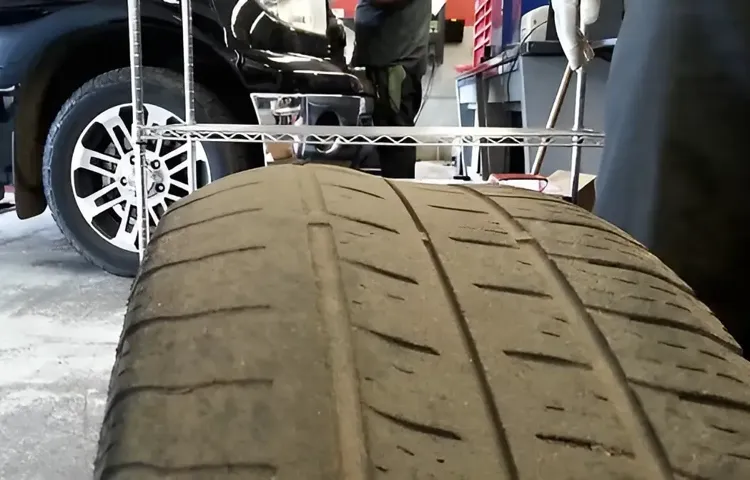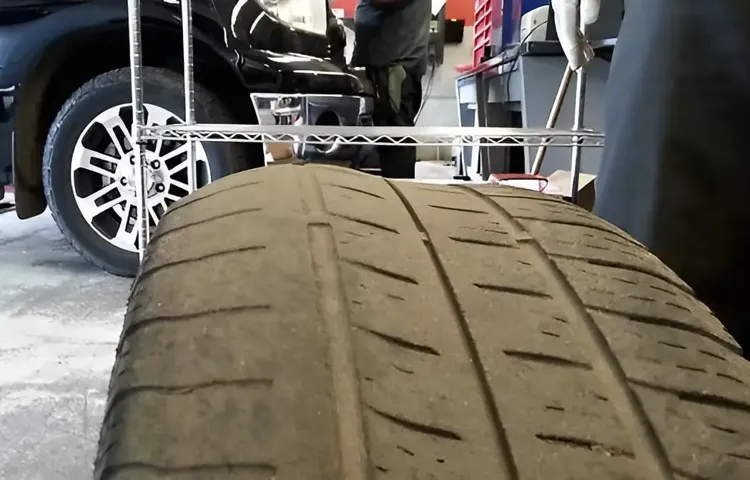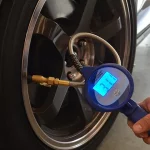Have you ever experienced a broken tire belt while driving? It’s a definitely unnerving situation that can leave you wondering how much longer you can drive before needing immediate repairs. The truth is, driving with a broken tire belt can be extremely dangerous and can cause significant damage to your vehicle. In this blog post, we’ll take a closer look at what a broken tire belt is, why it’s important to address the issue quickly, and how long you can safely drive your car with a damaged tire belt.
So buckle up and join us on this informative journey!
Table of Contents
What is a tire belt?
A tire belt is a component of a tire that provides added strength and stability to the structure. It consists of a band of steel cords, coated with rubber, that runs around the circumference of the tire. The belt is responsible for maintaining the tire’s shape and preventing its sidewalls from buckling under pressure.
If a tire belt gets damaged, it can cause serious problems for the tire’s performance and safety. The most common symptom of a broken belt is a vibration that gets worse as the vehicle’s speed increases. If you suspect that your tire belt may be broken, it’s important to get it inspected by a professional as soon as possible.
Driving on a tire with a broken belt can be dangerous, both to you and other drivers on the road. It’s always better to err on the side of caution and replace a damaged tire before it leads to a more serious issue. So, how long can you drive on a broken tire belt? The answer is, not very long.
It’s best to have the tire repaired or replaced as soon as possible to avoid any potential hazards.
Function and Importance
A tire belt is a layer of reinforced steel wires or synthetic materials that is placed between the tire tread and carcass. Its primary function is to provide strength and durability to the tire, making it resistant to punctures and improving its overall stability. The belt also plays a crucial role in maintaining the tire’s shape and prevents it from expanding too much in high-speed conditions.
Without a tire belt, the tire’s performance would be severely compromised, increasing the risk of blowouts and accidents. In a way, the tire belt is akin to a sturdy, protective shield that safeguards against potential hazards, allowing drivers to confidently travel on various road conditions. Investing in high-quality tires with a properly reinforced belt ensures safety on the road, as well as longevity and cost-effectiveness in the long run.

Signs of a Broken Tire Belt?
If you suspect that your tire belt has broken, it’s important to not ignore it. But what are the signs of a broken tire belt? One major indicator is a bulge or bubble in the sidewall of your tire. This can happen when the inner liner of the tire shifts due to the broken belt.
Another sign is a vibration or thumping sensation while driving, especially at higher speeds. Your vehicle may also pull to one side or the other. When it comes to how long you can drive on a broken tire belt, it’s best to not take any chances.
Continuing to drive on it can cause further damage and potentially lead to a blowout. It’s recommended to have the tire replaced as soon as possible to ensure a safe driving experience. So if you notice any of these signs, make sure to take action right away and keep yourself and your passengers safe on the road.
Symptoms to Watch Out For
If you’re a driver, you know how crucial it is to have well-maintained tires for your vehicle’s safety and performance. A broken tire belt can severely affect your tire’s integrity and performance, leading to potential accidents. So, what are the signs of a broken tire belt? Well, the most evident indication is a bulge or bubble on the tire’s sidewall.
This bulge may be located above or below the tire’s tread and may indicate that the steel belts within the tire are beginning to separate. Additionally, you may notice a vibration in the steering wheel or the driver’s seat, especially when driving at high speeds. Moreover, you may notice uneven tread wear or a wobbling sensation when driving.
Any of these signs can be an indication of a broken tire belt, and it is essential to get your vehicle to a professional mechanic for immediate attention. Remember, being proactive and checking your tires regularly can prevent hazardous situations and save you money in the long run. So, if you notice any of these symptoms, head over to a mechanic at the earliest.
Consequences of Driving on a Broken Tire Belt
If you have a broken tire belt, how long you can drive on it before causing severe damage to your car? The answer is not straightforward as it depends on various factors such as the severity of the damage, speed of driving, and road conditions. However, driving on a flat or bald tire with a broken belt can lead to severe consequences such as loss of control over the car, blowout, and severe damage to the car’s suspension system. A broken tire belt can cause uneven wear, making the tire more susceptible to punctures, blowouts, or hydroplaning.
Additionally, driving on a flat or damaged tire can cause overheating, leading to a more dangerous situation, and even a tire explosion. Therefore, if you notice any signs of a broken tire belt, such as vibrations, uneven wear, or a bulge in the sidewall, replace the tire immediately to avoid putting yourself and others on the road at risk.
Safety Risks and Potential Damage to Vehicle
Driving on a broken tire belt can have serious consequences, including safety risks and potential damage to your vehicle. A broken tire belt can cause your tire to deflate or blow out unexpectedly, leading to loss of control of your vehicle and potentially causing a dangerous accident. Additionally, driving on a tire with a broken belt can cause uneven wear and tear, leading to the need for premature replacements and potentially costing you more money in the long run.
It is essential to regularly inspect your tires for signs of wear and damage, including bulges, cracks, and uneven tread wear, to prevent the risk of driving on a broken tire belt. Don’t take the risk of driving on a damaged tire, as the consequences can be severe. Investing in proper tire maintenance and regular replacement can save you money and keep you safe on the road.
General Rule of Thumb for Driving on a Broken Tire Belt?
If you’re driving and suddenly feel a vibrating or shaking sensation, it’s likely that you have a broken tire belt. Driving on a broken tire belt can have serious consequences, which is why it’s important to address the issue as soon as possible. The most obvious consequence is reduced tire performance, which can make it harder to control the vehicle and stop safely.
In addition, a broken tire belt can cause tires to wear unevenly, leading to the need for more frequent replacements. Finally, driving on a broken tire belt can cause further damage to the wheel and even the suspension system, resulting in more costly repairs down the road. As a general rule of thumb, it’s best to stop driving immediately and have the tire inspected and replaced if necessary.
By taking prompt action, you can avoid potential safety hazards and save money in the long run.
What to Do If You Have a Broken Tire Belt?
If you find yourself with a broken tire belt, it is important to address the issue promptly. A broken tire belt can lead to a flat tire or even a blowout, increasing the risk of a dangerous situation on the road. As for how long you can drive on a broken tire belt? It’s best to avoid driving on a damaged tire altogether.
If you must drive, keep your speed low and avoid sudden turns or stops. Don’t push your luck or underestimate the severity of the issue, as it can lead to more significant safety concerns and a more expensive repair. The best course of action is to have a professional inspect and replace the tire as soon as possible.
Simply put, it’s better to err on the side of caution and replace a damaged tire promptly, rather than risking a more severe problem on the road.
Safety Precautions and Steps to Fix the Issue
If you ever find yourself in a situation where you have a broken tire belt, it’s important to take immediate action to ensure your safety. A broken tire belt can cause serious damage to your vehicle and put you and your passengers in danger. The first step is to pull over to a safe location, out of the way of traffic.
Once you’ve safely stopped your vehicle, inspect the tire for damage. If you notice any bulges, cracks, or punctures, it’s time to replace the tire. It’s also a good idea to inspect the other tires to make sure they’re still in good condition.
If you’re not comfortable changing the tire yourself, don’t hesitate to call for roadside assistance. Attempting to change a tire on your own without proper training can be dangerous. When it comes to your safety, it’s always better to err on the side of caution.
However, if you do decide to change the tire yourself, make sure you have all the necessary tools and follow a step-by-step guide to ensure you do it correctly. Remember, a broken tire belt isn’t something you should ignore. It’s a serious issue that needs to be addressed as soon as possible.
Taking the proper safety precautions and following the necessary steps to fix the problem will not only keep you and your passengers safe, but it will also ensure your vehicle stays in good condition for years to come.
Tips to Prevent Tire Belt Damage in the Future
Tire belt damage can be a frustrating problem to deal with, but there are ways to prevent it from happening in the future. One tip is to ensure that your tires are properly inflated to the manufacturer’s recommended PSI. Underinflated tires can cause excessive heat buildup, which can lead to tire belt damage.
Another tip is to avoid driving on uneven or rough roads as much as possible. If you do encounter a pothole or other obstacle, slow down and approach it slowly to minimize the impact. Additionally, regular tire rotations and inspections can help catch any issues early on and prevent them from progressing.
If you do experience a broken tire belt, it’s important to address it as soon as possible. Driving on a damaged tire can be dangerous and can cause further damage to your vehicle. If you notice any symptoms of tire belt damage, such as vibrations or a wobbling sensation while driving, pull over to a safe location and inspect your tires.
If the damage is severe, you may need to replace the tire. In some cases, a tire with a minor belt separation can be repaired, but it’s best to consult with a professional to determine the best course of action. By taking these steps, you can keep your tires in good condition and prevent future issues.
Conclusion
In summary, the answer to the question of how long you can drive on a broken tire belt is, well, a bit of a grey area. While it’s technically possible to continue driving with a broken belt, it’s not recommended. The risks to your safety and the condition of your vehicle increase significantly, so it’s always better to err on the side of caution and get it repaired as soon as possible.
Remember, a witty and clever conclusion is great, but never compromise on your safety for a cheap laugh. Drive safe, folks.”
FAQs
What is a tire belt and what role does it play in tire function?
A tire belt is a layer within a tire that adds stability and support to the tread. It helps the tire maintain its shape and prevents punctures and blowouts.
How can you tell if you have a broken tire belt?
Signs of a broken tire belt may include vibrations or uneven wear on the tire. You may also notice a bulge or bubble on the tire’s sidewall.
Is it safe to drive on a tire with a broken belt?
No, it is not safe to drive on a tire with a broken belt. The tire could experience a blowout, leading to loss of control of the vehicle and potentially causing an accident.
Can a broken tire belt be repaired?
No, a broken tire belt cannot be repaired. The tire must be replaced to ensure safe driving.
How long can you drive on a tire with a broken belt before it becomes unsafe?
It is difficult to give an exact timeframe, as driving on a tire with a broken belt is always unsafe. However, the longer you continue to drive on a damaged tire, the greater the risk of a blowout or accident.
What factors impact the lifespan of a tire belt?
The quality of the tire belt material, the tire’s proper inflation, and driving habits can all impact the lifespan of a tire belt.
How often should you inspect your tires for belt damage?
It is recommended to inspect your tires for damage, including belt damage, every time you fill up your fuel tank.



